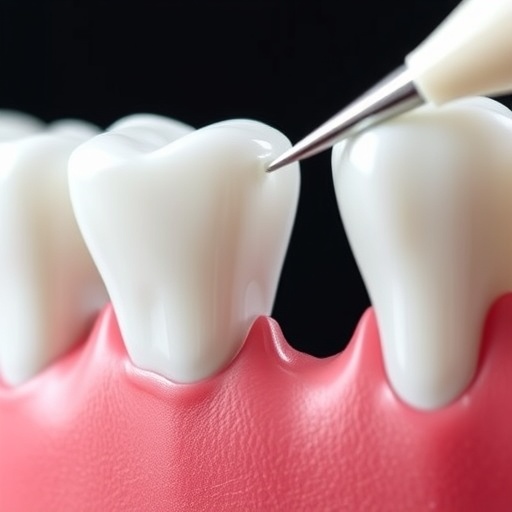In a significant advancement in dental care, researchers at the University of Nottingham have developed an innovative bioinspired gel that promises to repair and rejuvenate tooth enamel. This breakthrough could revolutionize preventive and restorative dental treatments, providing a long-term solution to a broadly recognized dental challenge affecting millions worldwide. The team, combining expertise from the University’s School of Pharmacy and Department of Chemical and Environmental Engineering, has unveiled findings that elevate the possibilities of dental health restoration, as reported in the prestigious journal Nature Communications.
Tooth enamel, the hard outer layer of teeth, serves as the first line of defense against decay. Its degradation is a common issue faced by nearly half the global population, leading to a myriad of dental problems that can culminate in severe complications, including infections and tooth loss. The traditional response to enamel loss has involved the use of fluoride treatments and various remineralization solutions. However, these treatments merely mask the symptoms rather than address the root cause of enamel degradation. The newly developed gel, however, emerges as a formidable contender capable of actually regenerating enamel.
The gel is characterized by a unique protein-based formulation that operates without fluoride. By mimicking the natural proteins involved in the development of dental enamel during infancy, the gel’s application is simple and mirrors the traditional fluoride treatment method used by dental professionals. Upon application, the gel forms an impermeable, yet delicate, layer over the teeth. This layer, in turn, is imbued with properties that enable it to penetrate into the myriad of small holes and cracks that form on enamel over time due to wear and tear.
At the core of this groundbreaking technology is a process known as epitaxial mineralization. This mechanism involves the gel acting as a scaffold that attracts and organizes calcium and phosphate ions from the saliva, effectively facilitating the growth of new enamel-like mineral structures. As these minerals accumulate, they integrate seamlessly with the underlying tooth tissue, mimicking the complex architecture of healthy enamel. This innovative approach not only restores the structural integrity of the enamel but also enhances its functional characteristics, protecting against physical, chemical, and thermal challenges.
Interestingly, the gel is not limited to treating demineralized enamel alone; it can also be applied directly onto exposed dentine. This capability opens up new avenues for treating dental hypersensitivity, an uncomfortable condition that affects many individuals. By creating an enamel-like layer over vulnerable dentine, the gel provides relief from sensitivity while simultaneously improving the bond strength of dental restoratives, ensuring longer-lasting dental treatments.
The implications of enamel regeneration extend beyond mere aesthetics. The deterioration of enamel is increasingly being linked to broader health concerns, including heightened risks for diabetes and cardiovascular diseases. Given that enamel, once lost, does not regenerate naturally, this innovative gel offers a much-needed strategy to combat the adverse effects of enamel loss.
Dr. Abshar Hasan, a postdoctoral fellow and lead author of the study, highlights the significance of this research, emphasizing the unique structure of dental enamel that provides remarkable protective properties. His enthusiasm reflects the optimism shared by his colleagues regarding the potential for this gel to revolutionize dental care. With extensive mechanical property tests conducted under simulated real-life conditions, the gel has shown promising results, performing under stressors such as tooth brushing, chewing, and exposure to acidic substances just like natural, healthy enamel.
Professor Alvaro Mata, who serves as Chair in Biomedical Engineering & Biomaterials and spearheads the research team, articulates the broader vision behind this innovation. The gel has been designed with both clinicians and patients in mind. The formulation is not only safe and easily applicable, but it also scales effectively, suggesting a feasible path toward commercial production. The excitement surrounding this development stems from the versatility of the technology, making it adaptable for various dental issues associated with enamel loss and exposed dentine across diverse patient demographics.
The research team is working toward bringing their innovation to the marketplace through their start-up company, Mintech-Bio, with hopes of launching a product within the next year. This effort indicates a proactive approach to translating scientific research into real-world applications that could significantly enhance the quality of dental care available to patients, potentially alleviating suffering for countless individuals affected by dental issues related to enamel loss.
Pivotal developments in dental care, such as this gel, could reduce the reliance on traditional and often insufficient treatments while offering an effective solution that not only addresses current ailments but also prevents future decay. The potential to restore the natural properties and structure of tooth enamel heralds a new era in dentistry, pushing boundaries of current treatments and aligning therapeutic possibilities with the needs of contemporary patients.
The landscape of dental healthcare is on the brink of transformation as researchers like those at the University of Nottingham continue to innovate, driven by the goal of improving patient outcomes and enhancing the resilience of one of the body’s most vital protective barriers. The future of tooth enamel restoration could soon become a reality, promising hope to millions affected by enamel degradation and redefining standards in dental health practices for generations to come.
Subject of Research: Tooth enamel regeneration
Article Title: Biomimetic supramolecular protein matrix restores structure and properties of human dental enamel
News Publication Date: 4-Nov-2025
Web References:
References:
Image Credits: University of Nottingham
Keywords
dental enamel, research, gel, tooth regeneration, University of Nottingham, epitaxial mineralization, dental care, biomimetic materials.
Tags: bioinspired dental gelenamel regeneration breakthroughfluoride-free tooth repairglobal dental health challengesinnovative dental treatmentslong-term enamel repair strategiesNature Communications dental studypreventive dental care solutionsprotein-based dental formulationsrestorative dentistry advancementstooth enamel restorationUniversity of Nottingham dental research





